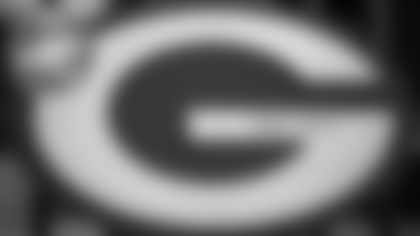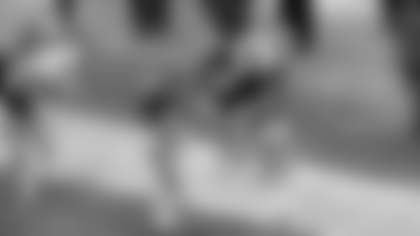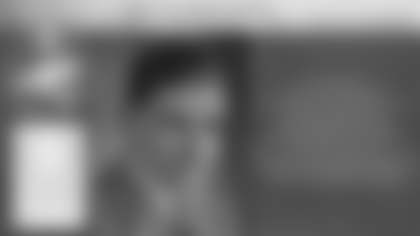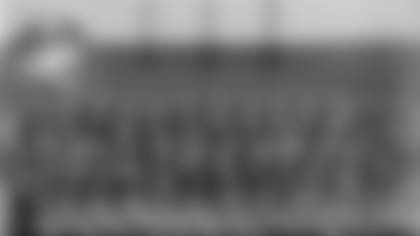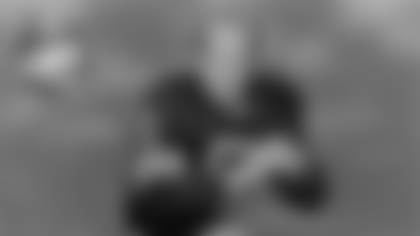Tim from Corvallis, OR
Your May 20 piece on "Don't Trust Wikipedia for Packers History" was linked on the Wikipedia criticism site. I'm a Wikipedian and decided to take on your assertions point by point that there was a mistake in five of the first eight sentences. Bear in mind I am not a Don Hutson expert or a Packers expert but do have a fair degree of expertise on 1930s and 1940s football.
I'll answer your points one by one. It appears that Hutson's Wikipedia site has been changed since I wrote that, but here were the errors I counted based on the questions you've raised.
- When he graduated from Alabama, Hutson did not plan on playing professionally. Two potentially inaccurate unsourced facts: that he graduated from Alabama and his career intentions.
I have no reason to doubt that's true, but I don't know if he graduated, either, or what his intentions were.
- In those days, the NFL was not highly regarded in the South compared to college football. This is absolutely, unquestionably a true statement.
I agree with you.
- But Green Bay Packers head coach Curly Lambeau saw Hutson as the perfect receiver for his passing attack, which at the time was headed by quarterback Arnie Herber and end John "Blood" McNally. Lambeau was one of the early adherents of passing-centric offense, per Jerry Roberts, "Pass Receiving in Early Pro Football: A History to the 1960s." QB Herber and end Johnny Blood McNally as the combo pre-Hutson? Herber was definitely the QB, just checked that, and he was a throwing QB, not a blocking back. The reference to Johnny Blood is the element that seems potentially wrong. I think he was a halfback. That's the factual error.
Here are the first two mistakes by my count.
No, Herber was not a quarterback. He started his first two NFL games there as a rookie in 1930 and never started another one at quarterback. Curly Lambeau determined Herber was unfit to play the position in his Notre Dame Box offense, and it had nothing to do with blocking. It was about Herber not being able to run the offense from the quarterback position, which was close to the line of scrimmage in Lambeau's Box.
After his first two games, Herber made 30 starts at right halfback and 17 at left halfback for the Packers. True, the Pro Football Hall of Fame lists Herber as a quarterback, but the people in Canton have gotten a lot of things wrong about early Packers history, especially the roles of the different backs in Lambeau's offense. Perhaps in modern-day football, Herber would be a quarterback. But he wasn't one when he played. Nor did Lambeau refer to either of his halfbacks as a tailback because the term wasn't applicable to how he used them.
And, you're right, Blood was not an end. For the Packers, he started 16 games at right halfback, 12 games at left halfback and four games at quarterback. In the Lambeau playbook that I have from the late 1930s, admittedly after Blood retired, the right halfback on a shift right, lined up in one of three spots: between the tackle and offensive right end, directly behind the right end and behind but just to the outside shoulder of the right end. I don't think it was any different when Blood played, although he may have taken a wider split on rare occasion but still from a position in the backfield.
While I didn't count the following as a mistake, I'd argue it qualifies as one. Herber to Blood was not the foremost NFL passing combo, or even the Packers' most prolific twosome, pre-Hutson.
One, Blood played for Pittsburgh in 1934, the year before Hutson was a rookie. Two, based on unofficial statistics provided by stats guru Eric Goska and taken from Green Bay Press-Gazette play-by-plays, Blood caught 84 passes in his first five seasons with the Packers from 11 different throwers – with the passer unknown for one of the completions.
Actually, the Packers' and perhaps the NFL's foremost passing combination before Hutson's rookie year was Red Dunn to Blood. Dunn completed 29 passes to Blood, the most of any Packer passer.
The sentence regarding the Herber-to-Blood combination reveals a lack of knowledge of Dunn's and Herber's careers, and, again, the particulars about Lambeau's Notre Dame Box offense.
There was no one back who regularly took the snaps from center. In Dunn's time as well as for most of Herber's career, any of the four backs could have taken the snap and any of the four could have thrown the ball. Dunn was essentially Lambeau's only passing quarterback in the 25 NFL seasons that he ran the Box. Dunn also called the plays. Herber was a passing halfback but generally didn't call signals.
From 1929-31, when Dunn and Blood were teammates, Herber attempted only 23 passes. In 1931, when Blood arguably had his best season with 20 catches, according to Goska's stats, including 10 for touchdowns, which is still a club-record for a back, he caught passes from six different backs.
Blood caught eight from Dunn for a 27.3 average, including five TDs of 28, 38, 14, 40 and 55 yards. Blood caught one pass from Herber for 19 yards. Blood also caught four each from fullback Bo Molenda and backup quarterback Roger Grove; two from another QB, Paul Fitzgibbon; and one from backup fullback Russ Saunders.
In 1932, when Herber became the Packers' primary passer, he and Blood hooked up on 17 passes for a 16.1 average and three TDs. But then in 1933, Blood caught only 10 passes, half of them thrown by rookie halfback Bobby Monnett, who was used to toss mostly short, catchable balls. Remember, that was the last season, where backs had to be at least five yards behind the line of scrimmage to attempt a pass.
Pre-Hutson, besides the 29 passes completed by Dunn, Blood caught 23 from Herber, 10 from halfback Verne Lewellen and no more than five from anyone else. However, in the two seasons before Hutson arrived, Blood caught only four passes from Herber for 76 yards, including one TD of 38 yards.
One last point: To me use of the name Johnny (Blood) McNally also suggests a lack of knowledge of Packers history. Johnny Blood was the only name used by the Packers in their press guides and programs when he played, and basically the only one that appeared on official NFL game sheets and in the Press-Gazette and Milwaukee newspapers, not to mention most out-of-town papers, as well.
As I wrote in my four-volume history of the Packers, "The Greatest Story in Sports," Johnny (Blood) McNally was essentially a 1963 Pro Football Hall of Fame concoction of his name, and it was as absurd as it would be to refer to Marilyn Monroe as Marilyn (Monroe) Mortenson or Norma Jeane (Monroe) Mortenson.
Having worked in the media for more than 35 years, I knew of at least a handful of local announcers who used on-air names different from their given names and never once saw anybody try to combine them. John McNally adopted the name of Johnny Blood as an NFL player, as was his legal right.
- By this time, a number of teams, including Alabama, were experimenting with spreading the field by moving one end far out near the sideline, drawing the defense away from running plays and leaving them more open on passing ones. This is a tactical question that I have no clue about. Alabama was regarded as no great passing innovator. Whether they were groundbreakers in splitting the left end is possible but not a given.
Sports editor Harry Grayson of the Newspaper Enterprise Association wrote in a preview story for the Jan. 1, 1935, Rose Bowl that Alabama coach Frank Thomas split his ends. That was Hutson's senior year. But how wide? That's the critical question. Because Braven Dyer, in his game preview for the Los Angeles Times, wrote: "Under the Notre Dame system, Alabama's ends are individually responsible for booming (blocking) the opposing tackle."
In Knute Rockne's Notre Dame Box, when the backs shifted before the snap, the ends also shifted a yard from the tackles to gain a better angle on the defensive tackles they had to block. Back then, that was often referred to as splitting the ends because they usually lined up tight to the tackles in other offenses. Seven-man defensive fronts were the norm, so ends were primarily used as blockers.
Having played quarterback for Rockne, Thomas ran the Notre Dame Box as a coach, just as Lambeau did in Green Bay.
I didn't count this as a mistake either, but the 1935 Rose Bowl was filmed and an almost 30-minute clip of most of the game's plays is available on YouTube. And with Hutson wearing No. 14 and playing left end, he's easy to spot on nearly every Alabama offensive play.
Not once that I could tell did he line up "far out near the sideline." Even on his two long touchdown passes, covering 54 and 59 yards, he was lined up roughly a yard from the left tackle. There were plays where he took a wider split, maybe three to five yards from the tackle, but not a lot.
I have a copy of a Thomas playbook and couldn't find any diagrams there, either, where an end moved "far out near the sideline."
As an FYI, the YouTube film is worth watching if you're interested in learning more about the Notre Dame Box. On Alabama's first offensive play, for example, it started with the shift. Alabama's backs lined up in a straight T-formation and shifted right with the left halfback taking the snap. The ends also shifted a yard outside the tackles at the same time.
Yet there are other plays where there's no shift – whether that's because Thomas' offense didn't call for it on every play or if the film simply missed the pre-snap action couldn't be determined – and instead the plays started with the backs in their Box alignment.
The one caveat I'd mention here is this: Thomas had an All-American left halfback in Millard "Dixie" Howell – called "the greatest football player I ever saw," by teammate Bear Bryant less than six weeks after the Rose Bowl – and it appeared most of the snaps from center were taken by him when he was in the game. Based on what Lambeau said about his offense and his playbook when he was coaching the Packers, snaps from center were shared by the different backs.
The film also offers insight into Hutson's role as an end and his impact as a receiver, at least at the college level. Every newspaper account seemed to have different stats for him in that game, but I believe six receptions for 165 yards and two touchdowns would be close to accurate.
Alabama won, 29-13, on three big plays, two of them the long passes to Hutson. No question, Howell and Hutson were the difference in what was otherwise a slugfest of mostly inside running plays. On Hutson's second TD, in particular, his burst of speed running away from the defensive backs in pursuit jumped out. Hutson also broke tackles and gained some tough yards on an early 18-yard reception.
It also was instructive watching him play left end on defense against Stanford's single- and double-wing offense featuring fullback Bobby Grayson. Arthur Daley of the New York Times wrote after Hutson's first four NFL seasons, when he played end on defense, opposing teams were running at him with impunity. No surprise there after watching that film.
- Hutson had thrived in this scheme, leading Lambeau to conclude that he would be the perfect fit for Green Bay's offense. This sort of ties together the whole line of reasoning that Lambeau was a passing innovator (true), that Lambeau sought Hutson for his offense (highly likely), and that the reason for this was because of what Hutson had done for Alabama's innovative offense in college (possible, but dubious).
Clearly, why would Lambeau sign Hutson if he didn't expect him to become a force in his passing attack? Then again, I think any profile of Hutson requires an explanation that he wasn't used like a wide receiver in today's pro football, either.
Consider the following quotes.
Cecil Isbell, the Packers' left halfback and record-breaking passer from 1938-42: "If Lambeau had put in the T-formation … we could have flanked Don then. He was in tight and had to block the tackle on those reverses to (Clarke) Hinkle."
Carl Mulleneaux, who played end opposite Hutson from 1938-41 and again in '45: "When Don played in the old days, he was close into the line and he'd have to break away from defensive ends and linebackers, and they really worked him over before he could get away."
Bob Snyder, who faced Hutson 12 times as a player with the Rams and Bears from 1937-41 and again in '43: "(Hutson) never was split from a damn tackle. He was a tight end."
That said, in Hutson's later years especially, Lambeau would split him wider than his other ends so he wouldn't take as much of a beating. At the same time, Nolan Luhn, the rookie end who played opposite him in 1945, said Hutson's usual split was roughly six yards from the tackle and occasionally more.
- Before the draft existed, college players could sign with any team they wanted, and while Hutson did sign a contract with Green Bay, he had also signed a contract with the NFL's Brooklyn Dodgers. First part: true. The first NFL draft came ahead of the 1936 season and Hutson came into the league in 1935; signing of two contracts: seems unlikely, but it is a question of biography.
- Both contracts came to the NFL office at the same time, and NFL president Joseph Carr declared that Hutson would go to Green Bay, as the Green Bay contract had an earlier date of signing. This directly relates to the second part above. Sourced to: John Eisenberg, "That First Season: How Vince Lombardi Took the Worst Team in the NFL and Set It on the Path to Glory." Probably a case of both being true or neither being true, depending on accuracy of the source.
Based on what so far has been a generous count, this was mistake three – arguably mistakes three and four.
The two contracts, and the postmark angle, is a story that has circulated for more than 80 years. I've read it in old newspaper articles going back to 1940 and in more recent books by writers I respect. But I've found no credible paper trail to prove it, especially the part about the postmarks.
I'll try to summarize the story here. But for more details, I wrote roughly five pages on the subject in our book, "The Greatest Story in Sports," https://www.packersproshop.com/the-greatest-story-in-sports
Let's start with Hutson's player personnel file in the NFL office. Hutson signed with the Packers on Feb. 19, 1935, the league's former senior vice president Greg Aiello told me in 2008. There was nothing in the file about him signing with Brooklyn or any other team.
The Packers, in turn, announced Hutson's signing three days later. "The Alabama star's contract was received by mail at the office of Coach E.L. Lambeau this morning," was the lead to the Press-Gazette story that ran on Friday, Feb. 22.
The next day, the Associated Press transmitted a story about Hutson signing with the Packers, and it appeared in newspapers across the country, including the Montgomery (Ala.) Advertiser. There also was a brief story about it in the Brooklyn (N.Y.) Citizen. Then that Saturday evening, AP sent out another story with a Birmingham, Ala., dateline, quoting player and Brooklyn minority owner Shipwreck Kelly as saying there must be some mistake about the Green Bay report because he had already signed Hutson to a contract.
Almost immediately, Hutson denied he had signed with Brooklyn in yet another story carried by AP, with a "University, Ala., Feb. 23" dateline. That story reported Hutson's teammate Charlie Marr had signed with Brooklyn, and that Kelly was en route to Tuscaloosa, home of the University of Alabama, to confer with Hutson.
On Sunday, Feb. 24, the Atlanta Journal shed light on Kelly's stops on his signing tour of college campuses. It reported he had been in Atlanta the previous day trying to sign Georgia Tech tackle Clyde Williams after stopping in Alabama on Friday, where he had signed Marr and tackle Bill Lee, another player Lambeau had been pursuing as actively as Hutson.
The Atlanta Journal quoted Kelly as saying that Hutson had signed "an agreement with him," and he planned to write to Lambeau asking him to release Hutson from his contract. "The thing probably will cause a lot of litigation if Green Bay doesn't release him, but I believe we stand a good chance of getting him," said Kelly.
However, the Nashville Banner, whose sports editor was the legendary and well-connected Fred Russell, tried to make sense of the three reports and what Kelly said about them "being perhaps a mix up," by declaring: "Kelly himself may not be sure, but there seems to be no 'if' about a mix up to everybody else."
It seemed settled. Hutson belonged to the Packers. And that appeared to be the end of the story, except that three weeks later, Lee sent a telegram to Lambeau explaining he had signed two contracts but didn't mail the one to Green Bay after Kelly upped his offer during a phone call.
So how did the postmark story come to be, gain traction and continue to endure?
First, as background, former Packers historian Lee Remmel, who covered Lambeau as a sportswriter for the Press-Gazette, once called him "a congenital liar." Several of Lambeau's former players and other writers have told me the same thing: That rarely was their much truth to be found in his stories.
There's also reason to wonder about Hutson's veracity, considering the tales he told regarding his track times and accomplishments at Alabama over the years.
As an example, Hutson repeatedly told reporters up until his death in 1997 that he consistently had been timed at 9.7 in the 100-yard dash at Alabama, which would have been faster than Jesse Owens' 9.8 winning time in the NCAA track finals Hutson's senior year and only a shade slower than Owens' world record at the time.
In truth, Hutson never even won the 100 in a dual meet at Alabama. In the Southeastern Conference meet his senior year, he placed fourth with 9.8 recorded as the winning time. His only posted time in the 100 that season was 10-flat, when he won Alabama's intra-campus meet.
Moving on, the deeper one digs into the story about Hutson's signing, there's little in the narrative of the last 80 years that matches the timeline of events and the actual whereabouts of the main characters in late 1934 and early '35.
For starters, Lambeau didn't attend the Rose Bowl, regardless of what he and Hutson later claimed. Lambeau was in San Francisco the week before the game, and at the East-West Shrine Game on Jan. 1, when the Rose Bowl was being played at the same time in Pasadena, Calif., almost 400 miles away. Moreover, at 9:30 the next morning, Hutson and his teammates boarded their Dixie Special in Pasadena and headed back to Alabama, while Lambeau was still in San Francisco, where he had submitted a summary to the Press-Gazette of the pro prospects he witnessed in the Shrine Game.
Back to the alleged double signing and postmark story.
It was five years later, when former NFL player Jimmy Conzelman wrote a first-person article in the St. Louis Post-Dispatch, based on an interview with Lambeau, about how Hutson had signed two contracts, one with the Packers and the other with the NFL Brooklyn Dodgers. Furthermore, NFL president Joe Carr awarded him to Green Bay based on the postmarks on the envelopes. The one from Green Bay was stamped 8:29 p.m.; the one from the Dodgers, 8:33 p.m., according to Conzelman's account.
Carr, the only person who would have been able to confirm whether any of it was true, had died 16 months earlier.
Between Lambeau and Hutson and sometimes together, they repeated that story countless times in interviews and speeches. But there was a problem: The number of versions they tossed out was almost as countless.
The time difference between postmarks offered by Lambeau and Hutson covered the gamut: first it was four minutes, then 17 minutes when Lambeau told the story again less than two months later to the New York Daily News. In 1960, Hutson told Oliver Kuechle of the Milwaukee Journal that the difference was 15 minutes with a.m. postmarks of 8:15 and 8:30. There were other stories that said the difference was 13 minutes, then 17 again with postmarks of 12:16 p.m. and 12:33 p.m., then 14 minutes; and then the last time Hutson told the story in 1994 at a press conference commemorating his selection to the NFL's 75th anniversary team, the gap was hours, not minutes.
Over the years, Hutson also told Remmel a version in 1965 that was similar to what was reported 30 years earlier: That he agreed to a deal with Kelly but didn't sign a contract with him. A few days later, when Kelly visited him in Tuscaloosa, Hutson said he told him he had signed with the Packers. Kelly, in turn, said he would contact Carr to see if anything could be done about it. According to Hutson, Carr ruled he was Packers' property.
Four years later, in a first-person story with the Milwaukee Sentinel, Hutson wrote in his lead that he had only "tentatively agreed to sign with Brooklyn."
Similarly, no mention was made of the double-signing and postmark story in the 1946 book, "The Green Bay Packers," written by Lambeau's close friend, the Chicago Tribune's Arch Ward. Although Ward apparently bought into Curly's made-up story about being in Pasadena and watching Hutson practice in advance of the game, he wrote that when Kelly arrived in Tuscaloosa after hearing about Hutson signing with the Packers, the response he got was: "Too late, Shipwreck!"
On the shadier side, Hutson told the local Lions Club in Green Bay in a 1941 talk that Kelly had slipped him $50 before the Rose Bowl. Then in 1960, Hutson told Kuechle he took $100 on the side from both Lambeau and Kelly before the Rose Bowl. Twenty-four years later, Hutson told the Palm Springs (Calif.) Desert that he took $500 from Kelly before the Rose Bowl.
No matter how many times someone tells a story, doesn't make it true. And without explaining and sourcing all of the above in detail, Wikipedia falls short of what I would consider minimum research and journalistic standards.
- Hutson later stated he chose the Packers because they offered the most money – $300 a game. "That was far and above what they had ever paid a player," said Hutson. "Each week they'd give me a check for $150 from one bank and $150 from another so nobody would know how much I was getting paid." Source is currently a dead link to the Milwaukee Sentinel.I have heard the story about two different banks before, actually. I'm inclined to rate this as a true quote, as remembered by an old football guy.
Hutson might have said that, but it's another fabrication and mistake No. 5 in less than 10 sentences on the Wikipedia page I originally referenced.
Again, Hutson's player personnel file notes that he signed for $175 a game. That also was the amount Lambeau, if he was telling the truth, said he signed Hutson for in a 1947 interview and again in Milwaukee Journal sports editor Chuck Johnson's 1961 book, "The Green Bay Packers." "Imagine getting him for a $175 a game," Lambeau had gushed in 1947.
In Myron Cope's 1970 book, "The Game That Was," Hutson also said he signed for $175 but got two checks each week: One for $100 and the other for $75.
Then in Richard Whittingham's 1984 book, "What a Game They Played," Hutson inflated the figures and said he signed for $300 and was given two $150 checks each week.
How does Wikipedia decide what to use and footnote in cases where numerous sources offer numerous versions of the same stories? Was there a legitimate reason for using what Hutson told Whittingham rather than what he told Cope, especially when what Cope wrote was supported by league records?
The company's name has changed but the Packers have had the same accounting firm since 1923, when they became a community property, and salaries were included with some of the corporation's annual and audited tax returns.
I haven't found a copy of the 1935 salaries yet, and I'm unable to search for them now because files are packed away during the current Lambeau renovation project.
But I do have the list for 1934, and Lambeau's salary as coach that year was $300 a game, and the highest-paid player was center Nate Barragar, who made $155 per game.
It's hard to imagine Lambeau paying Hutson just as much as a rookie as he might have been making himself, considering there's evidence Lambeau was still working under the same contract. Also, the Packers signed Hutson less than three weeks after emerging from a 17-month period in receivership. They weren't exactly flush with cash.
Casting additional doubt on what Hutson told Whittingham about Lambeau not wanting other players to know how much he was making was his 1939 salary. That was Hutson's fifth season, and his annual salary of $5,075 was only third highest on the team behind second-year man Cecil Isbell's $7,100 and Clarke Hinkle's $5,110.
Our records show Hutson collecting two salaries in 1945, his final season, when he was a player-coach. His playing salary was $11,950, tops on the team, and his salary as an assistant was $5,000.
Bottom line: There are not five big errors in eight sentences, as is intimated.
First, I did not claim there were five "big" errors in eight sentences. Regardless, in my mind, any factual mistake is a big mistake. My bottom line would be this: If you want to volunteer to correct what's wrong on Hutson's Wikipedia page or any other site about Packers history, I'd gladly provide you with the sources.
There's also one other questionable reference, if not mistake, in Hutson's current Wikipedia page. He's referred to as a safety on defense. Hutson played defensive end at 180 pounds in a seven-man line his first four seasons. Then he moved to defensive right halfback, according to an alignment Clarke Hinkle drew of the Packers' 1939 defense, and based on statements made by teammates and Lambeau.
Herm Schneidman, who played with Hutson from 1935-39 as a blocking back on offense and halfback on defense, told me, "Hutson also played defensive halfback but played end early." In 1942, Lambeau said, "Hutson is so good on defense that we use him at defensive right halfback, and he is one of the best." Three years later, before Hutson's final season, Lambeau said, "We play him at right half and sometimes safety."
At a time when the Packers were mostly using a 6-2-3 or 5-3-3 alignment, there's reason to wonder if they would have wanted him to be their last line of defense as a solo safety.
Pro Football Hall of Fame guard Mike Michalske, who played with Hutson for two years, said his teammate's idea of a tackle was "to run alongside (the player with the ball) and mark him like you would a rabbit … and then let somebody else tackle him."
In Hutson's day, offenses ran predominantly to the right or strong side, and former Detroit coach Potsy Clark said there were few offensive halfbacks in the entire league who posed much of a threat running back to the left or weak side. Hence, at right defensive halfback few runs would have come Hutson's way.
Michael from Milwaukee, WI
Just a note to tell you how thoroughly I enjoyed your piece on Verne Lewellen dated June 6, 2024. Because of the principals from the "Iron Man" era were players I am familiar with from my Milwaukee Badgers research, I found it most interesting. Thanks for writing such accurate and wonderfully presented and historical pieces. I also know Chris Willis and did some research assistance for him on his "Oorang" and "Grange" books. He's a meticulous and thorough researcher in his own right. By the way, I always imagined Conzelman as a seasoned self-promoter, so finding out that he failed to leave the room during deliberations regarding his HOF inclusion, only buttresses that opinion.
Thanks, and thanks for your loyalty as a reader. But I need to pass some praise here to Willis for the work he put into his "Iron Man" era book, and the meticulous research done by David Neft and Goska with early pro football and Packers statistics. And your book, "The Badgers: Milwaukee's NFL Entry of 1922-1926," met a high standard, too. Finally, what you said about Conzelman is another good reason for doubting the postmark story.
Andy from Atlanta, GA
I think I know why Lavvie Dilweg, Verne Lewellen and Cecil Isbell weren't elected the first years of the Pro Football Hall of Fame. It's likely voters were suffering from Packers fatigue.
That certainly can't be discounted. Over an 18-year span, from 1929-46, either the Packers or Bears won 12 NFL titles. When Bert Bell was coaching the Eagles back then, he said there weren't many players in the entire Eastern Division who could even start for the Packers or Bears. There are eight Packers in the Pro Football Hall of Fame from that era, and I think there at least another half-dozen who have the credentials to deserve serious consideration.
I get that there has to be a limit to how many Packers can be inducted. But I think Lewellen is a special case. And I'll admit that when I was on the hall's selection committee from 2001-14, I didn't realize that yet.
But since becoming team historian, I've read every Packers game story during Lewellen's nine seasons that I can access, not only in the Green Bay and Milwaukee newspapers, but the other league cities as well, and it seems fairly obvious Lewellen dominated many, if not most, of those games. And what I've also found was several quotes from players and others back then about Lewellen not only being the unquestioned star of the 1929-31, three-peat champs, but maybe Lambeau's greatest player based on inferences from the few Packers who played with him and then remained in Green Bay for part of if not all of Hutson's career.
In addition, there's Goska's unofficial play-by-plays, which show Lewellen's punting consistently being the difference in the outcome of games and also him making most of the big plays, especially in the biggest games.
If counted up, my research probably has taken hundreds of hours. Understandably, selection committee members from other NFL cities don't have the time to do the same. I just hope that this year, they'll be willing to ask three of pro football's most esteemed historians – Willis, Neft and former NFL executive and Hall of Fame selection committee member Joel Bussert – for their thoughts about Lewellen.




